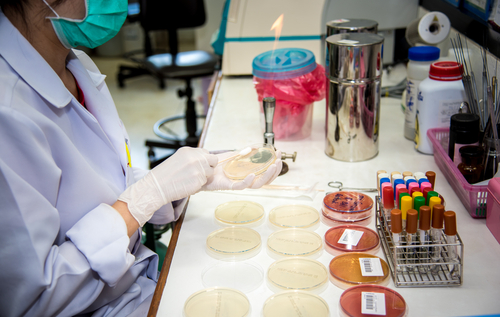A look at the recent advances in Microbiology
M3 India Newsdesk Jun 28, 2018
Much like the volatality of infectious diseases these days, microbiology research and medicine too is rapidly evoloving to counter and manage infections before they go out of control. Here's a snapshot of a few new findings in microbiology.

India, like many tropical countries, has a high prevalence of infectious diseases. On one hand, there are ancient infectious diseases such as tuberculosis and cholera that is still plaguing the population, and on the other hand, there are emerging new infectious diseases like Ebola, H1N1 flu, and Nipah. As per WHO (2016), India had 2.79 million cases of tuberculosis. In 2017, 22,186 cases of H1N1 flu were reported. For proper diagnosis and treatment of these infectious diseases, it is very important to understand the pathophysiology and the microorganisms involved.
This article discusses the latest microbiological breakthroughs, which help in understanding the pathophysiology of infectious diseases and aids in devising better ways to treat them.
Plasmodial phospholipases- Potential targets for malaria therapy
Malaria, caused by Plasmodium, can be treated effectively if the drugs can target certain cell structures vital for microbial survival. Plasmodial phospholipases are one such target. It is well-known that the growth of malaria parasite in the human body is facilitated by fine-tuning of lipid metabolism pathways. The phospholipases are important virulence factors as they play a crucial role in membrane dynamics during the infection, cell signalling, and cell-to-cell communication. Thus, the phospholipases are potential targets for malarial therapy. Functional characterisation of the plasmodial phospholipases must be done to validate its potential as a new target in malarial therapy.
Article: Phospholipases during membrane dynamics in malaria parasites. Flammersfeld A, Lang C, Flieger A, Pradel G. Int J Med Microbiol. 2017
Neutrophils- Promising targets for host-directed therapy to treat tuberculosis
Neutrophils and neutrophil-associated effectors are promising targets for host-directed therapy. Neutrophils form an important part of the active immune response against M.tuberculosis. The number of neutrophils and related factors have been found to be positively correlated to the stage of active infection. Preclinical studies revealed that neutrophils do not contribute to the protective immunity of the individual, rather it contributes to the lung pathology. Neutrophil and associated factors were found to be beneficial for the growth of M. Tuberculosis but is detrimental to the host cell.
Pharmacological interventions to deplete the neutrophils level and to interfere with the neutrophils-associated inflammation reduced the bacterial burden and increased the antibiotic efficiency and survival rate in the experimental models. Thus, targeting neutrophils for the adjunctive treatment of tuberculosis can be useful for reducing the duration of antibiotic therapy, decreasing the progression of tuberculosis and managing multidrug resistant tuberculosis infections.
Article: Targeting neutrophils for host-directed therapy to treat tuberculosis. Dallenga T, Linnemann L, Paudyal B, Repnik U, Griffiths G, Schaible UE. Int J Med Microbiol. 2017
Cyclophilin A- Potential target for treatment against drug-resistant Mycoplasma genitalium adhesion infection
Mycoplasma genitalium is a bacteria that caused sexually transmitted genitourinary infections in men and women. These bacteria can quickly become drug-resistant, and thus difficult to treat. Cyclophilin A, which is quite an abundant protein in humans, is a potential receptor of Mycoplasma genitalium adhesion protein (MgPa). The MgPa is the outer protein of Mycoplasma genitalium that plays an important role in binding and invading the host cell. The identification of this receptor will help in elucidating the pathogenic mechanism of Mycoplasma genitalium. With the discovery that Cyclophilin A is a receptor for MgPa, researches can be targeted to find a therapeutic way to prevent the binding of the adhesion protein to the receptors.
Article: Cyclophilin A is the potential receptor of the Mycoplasma genitalium adhesion protein. Deng X, Dai P, Yu M, Chen L, Zhu C, You X, Li L, Zeng Y. Int J Med Microbiol. 2018
Coxiella burnetii- A useful tool to investigate the host-pathogen interaction
To study the effectiveness of any anti-microbial therapy, it is important to understand the dynamics between the microbe and the host cell. This study requires a model that can exhibit the desired reactions. Coxiella burnetii has been found to be a perfect tool for studying the host-pathogen interaction as it reproduces rapidly in the host cell without affecting the viability of the host cell.
Coxiella burnetti has been found to modify its host cellular compartment to get the desired microenvironment. The desired microenvironment includes acidic pH, reduced oxygen tension and carbon dioxide. It gets the nutrients for survival by fusing with the endocytic, secretory and autophagic pathways. The nutrients are taken from the host by transporters. In case of a specific nutrient deficiency, it alters the expression of a gene which controls the transport and catabolism of nutrients. Moreover, C. burnettii causes Q fever only after years of initial infection.
This suggests that during the latency period, C. burnetii has been able to thrive and replicate within the host cell (by altering the microenvironment) without causing any significant effect on the host cell. Understanding how the microenvironment affects such host-pathogen interaction helps to develop strategies to curb the spread of bacteria and prevent chronic infections.
Article: Coxiella burnetii as a useful tool to investigate bacteria-friendly host cell compartments. Pechstein J, Schulze-Luehrmann J, Lührmann A. Int J Med Microbiol. 2017
Little breakthroughs that help us in understanding pathophysiology of a disease facilitate the development of efficient management strategies for infectious diseases. With the emergence of new infections on a frequent basis, it is crucial that we delve deeper into the infection and the host mechanisms so that we find out new strategies to treat infections.
-
Exclusive Write-ups & Webinars by KOLs
-
Daily Quiz by specialty
-
Paid Market Research Surveys
-
Case discussions, News & Journals' summaries